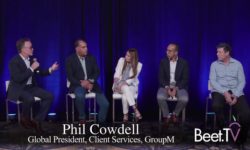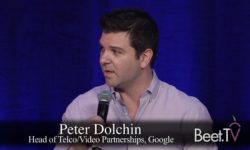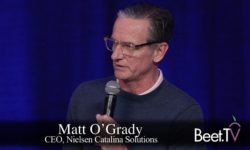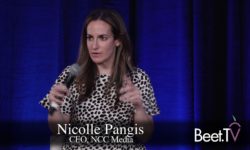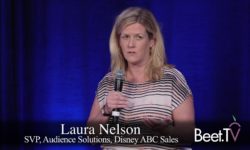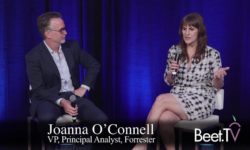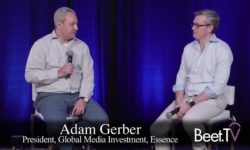SAN JUAN — For decades, the notion of return on investment from TV ads has been ironically straightforward.
Brands would buy ads and, with little insight in to who really watched what, would need to unleash a slew of media mix modelling tools to understand what exposures may have led to which purchases.
That imprecision has led the industry to focus on the half-full glass – TV is an amazing medium for building mass initial awareness, if not for closing a deal with a customer.
Now that over-the-top TV services and addressable TV advertising technologies, which allow for precision targeting, are coming on stream, the industry is contemplating changing the way it trades ads, like offering guarantees on business outcomes, measurable with digital attribution.
For an industry that is worth north of $70 billion in the US alone, the change could be profound. But how quick is it happening? What will the real nature of ROI look like? And who stands to gain?
At Beet Retreat, a panel representing all sides of the value chain – brand, agency, programmer, and technology supplier – was convened to thrash out the issues, concluding three days of debate in Puerto Rico. Here is what they said…
TV is not direct mail
The panel was cautioned against comparing the emerging technology of addressable TV to forebear marketing channels, just because it exhibits similar one-to-one qualities…
Vijay Konduru, VP Brand Sponsorships and Media, Discover
“There’s going to be this inherent reaction to treat addressable TV like it’s direct marketing or direct mail. But, if you benchmark the performance of, let’s say, addressable TV from an ROI perspective, from an effectiveness perspective, it’s never going to perform similarly to direct mail.”
Top of funnel still matters
Addressable and OTT TV ads can laser-guide creative to individual households or even individual viewers, just like digital – very different from conventional mass broadcast. But reaching that mass is still important…
Jonathan Steuer, Chief Research Officer, Omnicom Media Group:
“Awareness matters. The high-funnel stuff, brand-level marketing, actually really matters. In a rush to try to make everything accountable in a direct markety, outcome-based way, you end up minimizing the value of all that high-funnel stuff. We’ve done that largely because we never thought of making TV accountable at all. ”
ROI is a team sport
With so many technological possibilities at play, and the emerging possibility of selling ads only when an attribution can prove they have led to a purchase or other action, the whole notion of return on investment (ROI) is up in the air. But all sides of the value chain are playing the game…
John Hoctor, CEO & C0-Founder, Data Plus Math:
“Agencies, marketers, media folks (are now) partnering on (defining) ROI, which is kind of interesting. We’ll go on a lot of sales calls as the tech provider, as the glue that’s kind of holding it all together, to talk about what sort of outcomes can we measure for this particular advertiser. There’s some advertisers where the outcome is pretty clear, and you can measure it. There’s real budgets going against it. But it has not displaced the GRPs that are out there. But everyone is leaning into it. We’re in tons of these meetings with all of these folks. It’s a super hot topic.”
Turning around the TV ship
New technologies offer advertisers the ability to buy ads on TV in a manner consistent with digital – transacting not just for precise targeting but also buying specific business outcomes. But that is going to need the TV industry to change decades of habit…
Brian Norris, SVP, Audience Sales, NBCUniversal:
“TV has been transacted in a very similar way for the last 50 years or more. We’ve been really vocal about transitioning away from legacy measurement. Marketers by the way, are interested in that, and they’re leaned into it … (moving) into some sort of impact-, outcome-based measurement.”
Ashley Swartz, CEO, Furious Corp:
“But, still, 90% of your business is transacted against the Nielsen guarantee. $10 billion top line … moved against a currency that you and Linda (Yaccarino, Chairman of Advertising & Partnerships at NBCUniversal) and everybody openly express you feel needs to be refreshed. I guess maybe it’s also. ‘Guys, when is it worth the effort?'”
Jump right in
Beet Retreat heard frustration from attendees that many parts of the media-buying landscape still treat addressable TV advertising as a test-and-learn opportunity, with many holding back from significant investment. When could that change… ?
Jay Prasad, Chief Strategy Officer, VideoAmp:
“In 2018, a lot of it was research, so that you can prepare for how you want to start transacting moving forward. So by 2020, I’m hoping a lot of that volume, which is already pretty significant, is now moving into actual delivery, with measurement that is making buyers and sellers, both more effective in what they’re trying to do.”
This video was produced in San Juan, Puerto Rico at the Beet.TV executive retreat. Please find more videos from the series on this page. The Beet Retreat was presented by NCC along with Amobee, Dish Media, Oath and Google.







